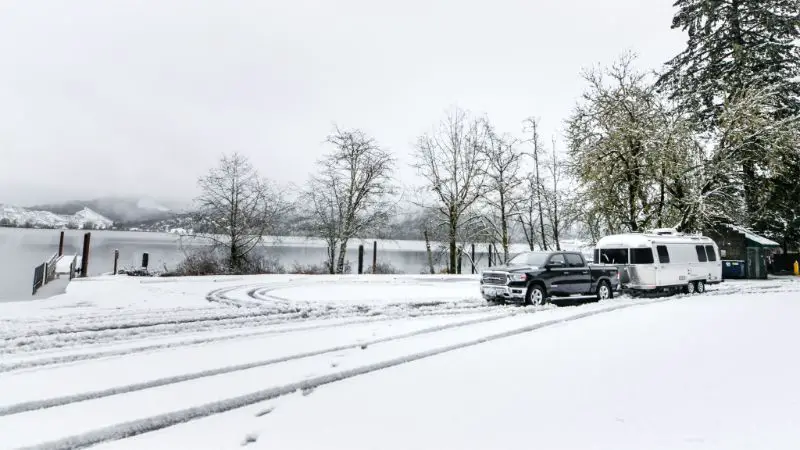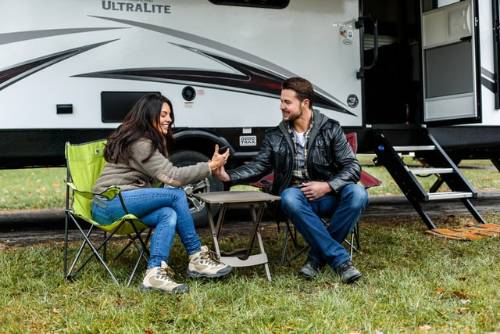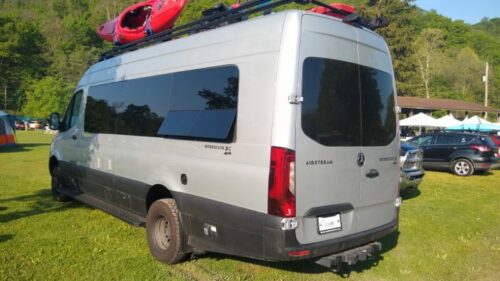
As George Carlin said, “Have you ever noticed that anybody driving slower than you is an idiot, and anyone going faster than you is a maniac?”
Let’s talk about RV speed. A popular forum question amongst RV owners is, “How fast can I drive my RV or tow my camper?”
Here are the 5 rules for driving safely with an RV:
- Don’t exceed the speed limit, which varies by state.
- Don’t exceed the speed rating of your tires at their correct inflation pressure for their actual weight.
- Listen to your vehicle, and don’t exceed your own abilities.
- Drive conservatively in adverse weather conditions.
- Save fuel by cruising at the lowest sustainable RPM in your highest gear.
Once you put all these rules together, most RVs should be driven or towed between 55 and 65 mph.
To most of us, that sounds slow. But guess what? It’s all in your head.
If you mosey along at 60 mph for 180 miles, you’ll get to your destination in three hours of driving time. That’s a sweet spot for many RVers: You’ll get decent gas mileage, avoid accidents, and stay under the speed limit.
If you decide to drive like a maniac at 72 mph (above the speed limit for RVs in almost every state), then you save a whopping … 17 minutes and 30 seconds. You could save that much time by getting rid of just one bathroom break. Or packing your snacks the night before.
However, it’s worth pointing out that driving 15-20 mph below the prevailing traffic can create a hazard in itself! So if everyone’s blowing by you at 80 mph, reconsider chugging along at 50 mph. You could be driving out of the frying pan into the fire.
Problems Caused by Driving Too Fast
- Wider turns. At faster speeds, RVs are more prone to rolling or tipping when turning. This is especially true for gasoline Class A’s with short wheelbases!
- Increased braking distance. The heavier your rig, the longer it takes to stop. Many driers are surprised to find that they have to break 2-5 seconds earlier than they’re accustomed to.
- Trailer sway. Higher speeds can amplify trailer sway oscillations. In extreme cases, they sway can overtake your tow vehicle and cause a fatal accident!
Decreased fuel economy. At higher speeds, you’re mostly fighting the wind more than just moving weight. And the force from wind exponentially increases with speed! - Shorter mechanical life. Driving an RV at high speeds means operating your engine at a higher RPM, and that means a shorter engine life, shorter transmission life, and more frequent oil and transmission fluid changes.
More fatality risk. Above 50 mph, the risk of death from an accident rises exponentially. - Brake wear or failure. A good rule of thumb is don’t descend hills faster than you can ascend them. If you can climb a mountain pass at 45 mph, go down it at the same speed. Pay attention to your brakes! Learn how to use engine braking, and pull over if necessary to let the brakes cool off. Pulse the brakes, don’t ride ‘em.
In the rest of this guide, let’s break down the four rules for choosing a safe speed limit.
An oft-cited statistic from a 2012 Federal Federal Motor Carrier Safety Administration report is that there are about 76,000 accidents involving RVs every year.
I dug around, however, and this isn’t strictly true. Conflicting sources say 76,000 injuries, or 76,000 accidents, or 76,000 people involved.
Plus, neither the FMCSA nor the NHTSA tracks accidents or collisions specifically by RV type. Because of their GVWR, RV motorhomes are often lumped with Large Trucks, and accidents with towable RVs aren’t broken down between travel trailers, and say, landscaping utility trailers.
So just be aware that most of the cited RV accident statistics out there on the Internet seem to be flawed or even flat-out wrong.
Rule 1: Don’t Exceed the Speed Limit
If you pilot a motorhome or tow a camper, you can’t assume the posted speed limit always applies to you.
Several states have additional restrictions based on GVW, length, or weight. And some states further restrict speed limits if you’re towing.
At one time, most states limited maximum speed while towing to 55 mph. This has been mostly eliminated over the years, but several states do still restrict maximum speed while towing.
Here’s a table showing the speed limits for RVs across U.S. states. This table is accurate as of May 2022, but do your diligence and check your state laws beforehand! Partial credit to the guys at RVNerds.com.
P.S. If your motorhome weighs more than 26,000 pounds or your camper weighs more than 10,000 lbs, you may be subject to additional restrictions.
RV Speed Limits By State
| State | Rural Interstate | Urban Interstates | Limited Access Roads | Other | RV |
|---|---|---|---|---|---|
| Alabama | 70 | 65 | 65 | 65 | |
| Alaska | 65 | 55 | 65 | 55 | |
| Arizona | 75 | 65 | 65 | 65 | trucks: 65 | If towing, cannot cause lateral sway. |
| Arkansas | 75 | trucks: 70 | 65 | 75 | trucks: 70 | 65 | If towing, 70/55 rural interstates/urban freeways |
| California | 70 | trucks: 55 | 65 | trucks: 55 | 70 | trucks: 55 | 65 | trucks: 55 | 70 motorhome | 55 for any vehicle towing |
| Colorado | 75 | 65 | 65 | 65 | |
| Connecticut | 65 | 55 | 65 | 55 | |
| Delaware | 65 | 55 | 65 | 55 | |
| District of Columbia | n/a | 55 | n/a | 25 | |
| Florida | 70 | 65 | 70 | 65 | |
| Georgia | 70 | 70 | 65 | 65 | |
| Hawaii | 60 | 60 | 55 | 45 | |
| Idaho | 75 | 80 where posted | trucks: 70 | 75 | 80 where posted | trucks: 65 | 70 | 70 | 70 |
| Illinois | 70 | 55 | 65 | 55 | |
| Indiana | 70 | trucks: 65 | 55 | 60 | 55 | 70 where posted | 65 mph if GVWR<26k | if towing, 55 mph elsewhere |
| Iowa | 70 | 55 | 70 | 65 | |
| Kansas | 75 | 75 | 75 | 65 | |
| Kentucky | 65 | 70 where posted | 65 | 65 | 55 | |
| Louisiana | 75 | 70 | 70 | 65 | |
| Maine | 75 | 75 | 75 | 60 | |
| Maryland | 70 | 70 | 70 | 55 | |
| Massachusetts | 65 | 65 | 65 | 55 | |
| Michigan | 70/75 where specified | trucks: 65 | 70 | 70 | 55 | |
| Minnesota | 70 | 65 | 65 | 60 | |
| Mississippi | 70 | 70 | 70 | 65 | |
| Missouri | 70 | 60 | 70 | 65 | |
| Montana | 80 | trucks: 70 | 65 | day: 70 | night: 65 | day: 70 | night: 65 | 70 if exceeding 26k GVW | 10 mph less than general limit |
| Nebraska | 75 | 70 | 70 | 65 | |
| Nevada | 80 | 65 | 70 | 70 | |
| New Hampshire | 65/70 where posted | 65 | 55 | 55 | |
| New Jersey | 65 | 55 | 65 | 55 | |
| New Mexico | 75 | 75 | 65 | 55 | |
| New York | 65 | 65 | 65 | 55 | |
| North Carolina | 70 | 70 | 70 | 55 | |
| North Dakota | 75 | 75 | 70 | 65 | |
| Ohio | 70 | 65 | 70 | 55 | |
| Oklahoma | 75/80 where posted | 70 | 70 | 70 | |
| Oregon | 65/70 where posted | trucks: 55/65 where posted | 55 | 65 | 65 | |
| Pennsylvania | 70 | 70 | 70 | 55 | |
| Rhode Island | 65 | 55 | 55 | 55 | |
| South Carolina | 70 | 70 | 60 | 55 | |
| South Dakota | 80 | 80 | 70 | 70 | |
| Tennessee | 70 | 70 | 70 | 65 | |
| Texas | 75/80-85 where posted | 75 | 75 | 75 | |
| Utah | 75/80 where posted | 65 | 75 | 65 | |
| Vermont | 65 | 55 | 50 | 50 | |
| Virginia | 70 | 70 | 65 | 55 | |
| Washington | 70/75 where posted | trucks: 60 | 60 | 60 | 60 | 60 | same rules as trucks |
| West Virginia | 70 | 55 | 65 | 55 | |
| Wisconsin | 70 | 70 | 70 | 55 | |
| Wyoming | 75/80 where posted | 75/80 where posted | 70 | 70 |
Rule 2: Don’t Exceed the Speed Rating of Your Tires
I’ve written extensively about the relationship between tire pressure, inflation, and speed.
Speed ratings are one of those gray scientific areas. A tire rated for 65 mph, for instance, isn’t necessarily going to blow up at 70 mph. That’s the design operating speed. And there isn’t a single DOT-approved test that companies use to quality their tire speed ratings.
In fact, according to Roger Marble, the higher load capacity of an ST tire relative to, say, an LT tire is based on a lower operating speed of 65 mph.
If that sounds like techno-mumbo-jumbo, that’s OK. What you need to know is that:
- A faster tire is a hotter tire, and heat kills tires.
- Also, an underinflated tire is a weaker (and usually hotter) tire, which further kills tires.
And when you lastly realize that most RVs are habitually overloading and/or underinflating at least one of their tires .. you quickly realize that exceeding the stated operating speed of 65 mph is a big reason why RV tires blow out!
Keep your tires inflated to their maximum stated pressure. Don’t exceed their speed ratings – and for that matter, don’t blindly trust their speed ratings too much, anyways.
Rule 3: Listen to Your Vehicle (and Your Spouse)
The physics around RVs is extremely complicated. You’re basically pushing or pulling a brick-shaped object through turbulent air, up and down grades, around banked corners, on a suspension that can move in 3D motion. There are incredibly powerful forces, in particular, between a tow vehicle and a heavy camper.
So don’t listen to someone who claims he can pull your exact same make and model of camper at 75 mph without breaking a sweat. He might live in Iowa, and you live in Colorado. Or he tows with a Silverado 3500 dually, and you’re squeaking by with a long-bed Ford F-250. Or he uses one type of weight-distribution hitch, and you use another.
Listen to your vehicle. If you notice an increase in trailer sway at 58 mph, try speeding up to 62 or slowing down to 55. Just a few mph can make a big difference in vehicle stability.
Speaking of which, your choice of weight-distribution hitch is one of the most important purchasing decisions you can make as a camper owner. Don’t buy one because it’s cheap. Buy one because it works well to equalize the load and prevent sway.
Also, listen to your spouse (or your conscience). We weren’t all born Mario Andretti. If you white-knuckle mountain roads, don’t try to appease the masses. Let them honk. Stay safe. If you tend to zone out while enjoying the scenery, don’t speed; you might rear-end the guy in front of you!
Rule 4: Drive Conservatively in Bad Weather
In almost every respect, an RV has poor vehicle dynamics.
- They’re tall, so they tip or roll over easily.
- They’re wide, so they cause enormous air turbulence.
- They’re long, so they act as a sail for crosswinds.
RVs take longer to accelerate and more distance to brake. They don’t handle winds well, and their tires can easily lock up in icy conditions.
Many times, your camper weighs as much as your tow vehicle! Or your motorhome weighs more than a fully loaded U-Haul.
Let the weather and road conditions dictate how your drive. Follow the adage: Snow, go slow. Ice, no dice!

Keep at least 3-4 seconds behind any vehicle, even in good weather. In poor road conditions or steep grades, increase that distance to at least 5-6 seconds.
Rule 5: Save Fuel By Driving Slowly
As a rough rule of thumb, you’ll get the best gas mileage by cruising in your highest gear at the lowest RPM.
There’s a caveat, here. Many pickup trucks and SUVs have an “overdrive” gear for even better fuel efficiency. However, read your Owner’s Manual! Many manuals instruct you to turn off your Overdrive gear while towing; some only allow you to engage Overdrive if towing light loads on flat terrain.
Most drivers find the best balance of comfort, speed, and fuel economy at 55-62 mph. Your mileage may vary, of course.
Andy Herrick is a blogging nerd, #8 Enneagram, wannabe bread baker, INTJ, RV industry professional, and small business entrepreneur. He can be found hanging out with his lovely wife and family, skiing, cycling, climbing, hiking, and convincing anyone who will listen why dogs aren’t really that great of pets. Also, he runs this website.









